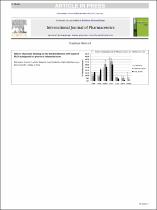 ResearchSpace
ResearchSpace
Effects of protein binding on the biodistribution of PEGylated PLGA nanoparticles post oral administration
JavaScript is disabled for your browser. Some features of this site may not work without it.
- ResearchSpace
- →
- Research Publications/Outputs
- →
- Journal Articles
- →
- View Item
| dc.contributor.author |
Semete, B

|
|
| dc.contributor.author |
Booysen, L

|
|
| dc.contributor.author |
Kalombo, Lonji

|
|
| dc.contributor.author |
Ramalapa, B

|
|
| dc.contributor.author |
Hayeshi, R

|
|
| dc.contributor.author |
Swai, HS

|
|
| dc.date.accessioned | 2012-04-16T09:49:42Z | |
| dc.date.available | 2012-04-16T09:49:42Z | |
| dc.date.issued | 2012-03 | |
| dc.identifier.citation | Semete, B, Booysen, L, Kalombo, L, Ramalapa, B, Hayeshi, R and Swai, HS. 2012. Effects of protein binding on the biodistribution of PEGylated PLGA nanoparticles post oral administration. International Journal of Pharmaceutics, vol. 424(1-2), pp 115-120 | en_US |
| dc.identifier.issn | 0378-5173 | |
| dc.identifier.uri | http://www.sciencedirect.com/science/article/pii/S0378517311011732 | |
| dc.identifier.uri | http://hdl.handle.net/10204/5761 | |
| dc.description | Copyright: 2011 Elsevier. This is the post-print version of the work. The definitive version is published in the International Journal of Pharmaceutics, vol. 424(1-2), pp 115-120 | en_US |
| dc.description.abstract | The surface of nanoparticles is often functionalised with polymeric surfactants, in order to increase systemic circulation time. This has been investigated mainly for intravenously administered nanoparticles. This study aims to elucidate the effect of surface coating with various concentrations of polymeric surfactants (PEG and Pluronics F127) on the in vitro protein binding as well as the tissue biodistribution, post oral administration, of PLGA nanoparticles. The in vitro protein binding varied depending on the polymeric surfactant used. However, in vivo, 1% PEG and 1% Pluronics F127 coated particles presented similar biodistribution profiles in various tissues over seven days. Furthermore, the percentage of PEG and Pluronics coated particles detected in plasma was higher than that of uncoated PLGA particles, indicating that systemic circulation time can also be increased with oral formulations. The difference in the in vitro protein binding as a result of the different poloxamers used versus similar in vivo profiles of these particles indicates that in vitro observations for nanoparticles cannot represent or be correlated to the in vivo behaviour of the nanoparticles. Our results therefore suggest that more studies have to be conducted for oral formulations to give a better understanding of the kinetics of the particles. | en_US |
| dc.language.iso | en | en_US |
| dc.publisher | Elsevier | en_US |
| dc.relation.ispartofseries | Workflow;8762 | |
| dc.subject | Nanoparticles | en_US |
| dc.subject | Nanotechnology | en_US |
| dc.subject | Polymeric surfactants | en_US |
| dc.subject | Protein binding | en_US |
| dc.subject | PEGylated PLGA nanoparticles | en_US |
| dc.title | Effects of protein binding on the biodistribution of PEGylated PLGA nanoparticles post oral administration | en_US |
| dc.type | Article | en_US |
| dc.identifier.apacitation | Semete, B., Booysen, L., Kalombo, L., Ramalapa, B., Hayeshi, R., & Swai, H. (2012). Effects of protein binding on the biodistribution of PEGylated PLGA nanoparticles post oral administration. http://hdl.handle.net/10204/5761 | en_ZA |
| dc.identifier.chicagocitation | Semete, B, L Booysen, Lonji Kalombo, B Ramalapa, R Hayeshi, and HS Swai "Effects of protein binding on the biodistribution of PEGylated PLGA nanoparticles post oral administration." (2012) http://hdl.handle.net/10204/5761 | en_ZA |
| dc.identifier.vancouvercitation | Semete B, Booysen L, Kalombo L, Ramalapa B, Hayeshi R, Swai H. Effects of protein binding on the biodistribution of PEGylated PLGA nanoparticles post oral administration. 2012; http://hdl.handle.net/10204/5761. | en_ZA |
| dc.identifier.ris | TY - Article AU - Semete, B AU - Booysen, L AU - Kalombo, Lonji AU - Ramalapa, B AU - Hayeshi, R AU - Swai, HS AB - The surface of nanoparticles is often functionalised with polymeric surfactants, in order to increase systemic circulation time. This has been investigated mainly for intravenously administered nanoparticles. This study aims to elucidate the effect of surface coating with various concentrations of polymeric surfactants (PEG and Pluronics F127) on the in vitro protein binding as well as the tissue biodistribution, post oral administration, of PLGA nanoparticles. The in vitro protein binding varied depending on the polymeric surfactant used. However, in vivo, 1% PEG and 1% Pluronics F127 coated particles presented similar biodistribution profiles in various tissues over seven days. Furthermore, the percentage of PEG and Pluronics coated particles detected in plasma was higher than that of uncoated PLGA particles, indicating that systemic circulation time can also be increased with oral formulations. The difference in the in vitro protein binding as a result of the different poloxamers used versus similar in vivo profiles of these particles indicates that in vitro observations for nanoparticles cannot represent or be correlated to the in vivo behaviour of the nanoparticles. Our results therefore suggest that more studies have to be conducted for oral formulations to give a better understanding of the kinetics of the particles. DA - 2012-03 DB - ResearchSpace DP - CSIR KW - Nanoparticles KW - Nanotechnology KW - Polymeric surfactants KW - Protein binding KW - PEGylated PLGA nanoparticles LK - https://researchspace.csir.co.za PY - 2012 SM - 0378-5173 T1 - Effects of protein binding on the biodistribution of PEGylated PLGA nanoparticles post oral administration TI - Effects of protein binding on the biodistribution of PEGylated PLGA nanoparticles post oral administration UR - http://hdl.handle.net/10204/5761 ER - | en_ZA |





